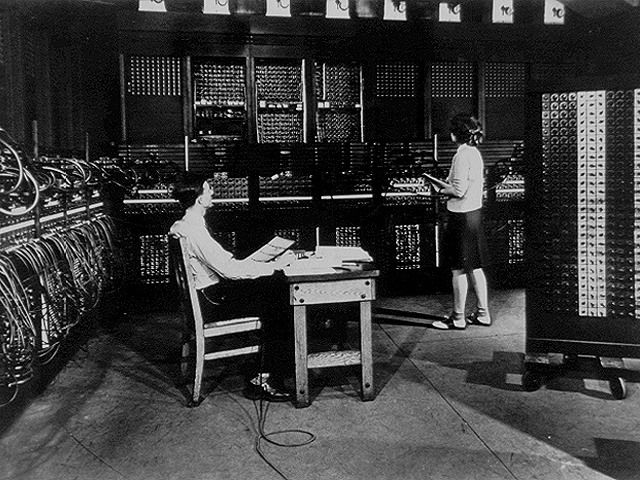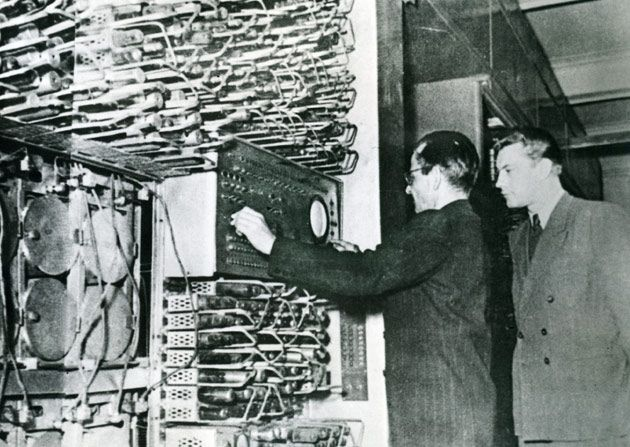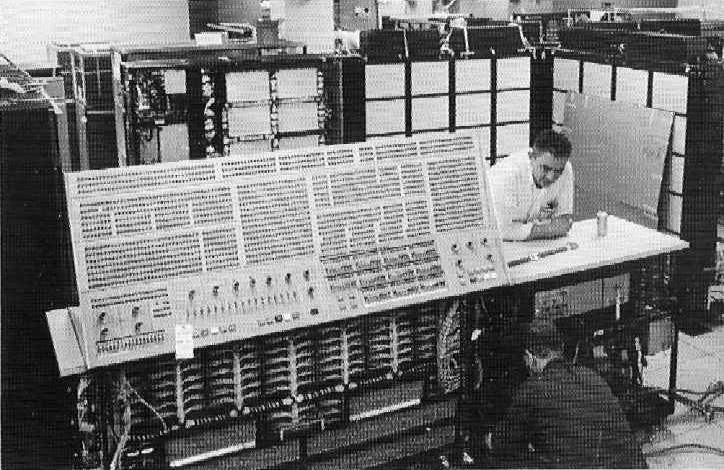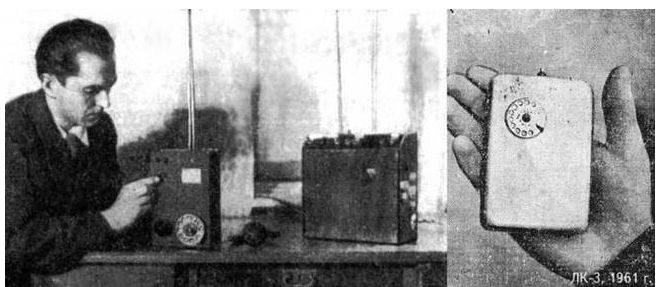
 Why has a well-staffed, resource-rich, and highly capable industrial system nearly vanished in just twenty years?Author: Chen SiwenEditor: Yan YuFor Americans, April 12, 1961, was a frustrating day. While Washington was still asleep, the Moscow radio station in the Soviet Union began broadcasting the classic red song “How Vast and Great is Our Motherland”—followed by an announcement that shook the entire human society: the world’s first manned spacecraft, “Vostok,” had been launched by the Soviet Union.
Why has a well-staffed, resource-rich, and highly capable industrial system nearly vanished in just twenty years?Author: Chen SiwenEditor: Yan YuFor Americans, April 12, 1961, was a frustrating day. While Washington was still asleep, the Moscow radio station in the Soviet Union began broadcasting the classic red song “How Vast and Great is Our Motherland”—followed by an announcement that shook the entire human society: the world’s first manned spacecraft, “Vostok,” had been launched by the Soviet Union.
27-year-old Soviet Air Force Lieutenant Yuri Gagarin piloted the spacecraft, orbiting the Earth in 1 hour and 48 minutes. Schoolchildren, workers, and salespeople across the Soviet Union poured out of their homes to gaze at the sky. They welcomed their new hero with 20 salutes, a sea of flowers, the naming rights to a square, and the title of “Soviet Columbus.”

But on the other side of the Pacific, Americans were seething with anger.
At 4 PM, President Kennedy attended a heated press conference, where he reluctantly admitted that the United States had indeed fallen behind in manned spaceflight. But frustrated and angry Americans were not ready to let him off the hook. One NASA scientist shook his fist and shouted, “Kennedy is doomed to fail in the next election.” Another astronaut complained to reporters:
If someone had decided two years earlier to get us up there, we would have been the ones.
Historically aware Americans were especially enraged, as they were surrounded by a sense of self-inflicted shame—forty years earlier, it was with American assistance that the Soviet Union had completed its industrialization. “Without us, they could only produce potatoes; they should be sent back to being a worthless waste.” a U.S. news magazine wrote.
Faced with an angry public, Kennedy’s attitude was ambiguous: “We will engage in fields where we can lead, which will bring long-term benefits to humanity.” But upon returning to the White House, the president told his cabinet, “We need to invent a competition that is beneficial to us on Earth.”
A contest that would impact all of human civilization had begun.
 01 The Beginning of the Challenger
01 The Beginning of the Challenger
The concerns of Americans were well-founded, as in the early 1960s, there was almost no gap between the Soviet Union and the United States.
In 1960, the Soviet Union launched its nuclear submarine, which possessed nuclear weapons and intercontinental missiles of over 100 million tons, and later developed rockets capable of sending satellites and humans into space. American physicists also discovered that the Soviets were keeping pace even more closely in the emerging electronics and computer industries.
As early as 1946, the United States introduced the first digital electronic computer, ENIAC, which could perform 5,000 calculations per second but could only operate continuously for 20 hours. Four years later, the Soviets invented the MESM, which, although slightly less powerful, was more durable due to a 65% reduction in vacuum tubes.

The first Soviet computer, MESM
In 1955, Bell Labs in the United States developed the world’s first all-transistor computer, TRADIC. Four years later, the Soviets also produced their own transistor computer, M-4, which succeeded based on fundamental scientific research. Thanks to the efforts of Soviet scientists, the Soviet transistor was only a few weeks behind the U.S. version.
The rivalry between the two camps put pressure on Americans once again after World War II. After the initial shock, the government and academia began to calm down and study the reasons why the Soviets made Americans feel inferior. Ultimately, they discovered that the unconditional aid from the U.S. before the war and the post-war push for fundamental research by the Soviets were key to the Soviet Union’s rise to become the second strongest nation.
In 1928, the Soviet Union was a backward agricultural country standing on the ruins of war. Its industrial output was only one-eighth that of the United States, with over 90% of farming relying on animal and human power, and light industry lagging behind, while heavy industry was virtually nonexistent.
This meant that the Soviet Union was still at the level of the First Industrial Revolution. Its leaders were extremely eager to catch up quickly, but this required long-term technological and financial accumulation. The shortcut they ultimately chose was to rely on domestic capital accumulation and foreign technology for sedimentation.
To raise the funds needed for industrial construction, the Soviet Union adopted a method of “using agriculture to subsidize industry,” transferring agricultural profits to industry through agricultural collectivization and the industrial-agricultural price scissors, as well as exporting grain to exchange for foreign exchange. During the two Five-Year Plans from 1928 to 1938, the funds provided by Soviet agriculture were roughly equivalent to the total fixed asset investment of the country during the same period.
The funds used by the Soviet Union to develop industry came from the entire population tightening their belts.
But just having funds was not enough; the Soviet Union also needed to solve the problems of technology and equipment. Looking at the world, the United States was the most advanced industrial country, and it was an external aid that the Soviet Union could not bypass. Its attitude towards the Soviet Union was particularly precious and important; in a sense, it was the only opportunity for the Soviet Union’s economic reconstruction.
Fortunately, the Soviet Union seized this irreplaceable opportunity. Looking back today, it was almost a perfect coincidence of circumstances and national fortune, enough to evoke a sense of divine providence for the Soviet Union.
At that time, although the Soviet Union was politically isolated, international trade could still flow freely. More importantly, during the implementation of the first Five-Year Plan (1928-1932), the world experienced a global economic crisis, and the United States happened to be at the center of the vortex.
On one side was a huge demand for materials and technology, and on the other side was an oversupply of products, engineers, and skilled workers. This naturally created a favorable supply-demand relationship, allowing both the U.S. and the Soviet Union to see the possibility of national-level transactions.
In 1929, 1,123 American companies signed supply contracts with the Soviet Union, followed by British and German companies. As a result, during the first Five-Year Plan, the Soviet Union became the country that imported the most machinery and equipment in the world; in 1931 alone, 50% of the machinery exported by the United States was sold to the Soviet Union.
In the aid to the Soviet Union, the Americans were remarkably generous.
In the construction of the Magnitogorsk Iron and Steel Works in the Soviet Union, 450 American engineers worked day and night, drawing construction blueprints that were precise down to every screw and nut. They used the latest American concepts and technologies, which made the Magnitogorsk Steel Works the largest and most advanced steel enterprise in the world upon completion.
It was a creation-like era of construction, with a continuous influx of American technology and equipment, combined with the enthusiasm of the entire Soviet population, leading to record after record.
During the two Five-Year Plans, the complete sets of equipment and technology for the three major steel plants in Magnitogorsk, Kuznetsk, and Zaporizhia all came from the United States; the famous Stalingrad Tractor Plant was basically assembled from equipment dismantled from American tractor factories. The three major automobile plants that formed the framework of the Soviet automobile industry were entirely based on the American Ford model.
All these projects relied on American support. During the first Five-Year Plan, 20,000 foreign experts came to the Soviet Union, distributed across all fields from central departments to factories and workshops. Clearly, for a country with a 50% illiteracy rate in 1928, this was a more valuable asset than materials and equipment.
American aid to the Soviet Union is rare in the history of global technology transfer. Due to the later hostile stance, it is rarely mentioned by the United States, but its impact on the Soviet Union is hard to express—it was equivalent to teaching the Soviet Union how to build a complete industrial system hand in hand.
In January 1933, the Soviet Union completed its first Five-Year Plan ahead of schedule, and Stalin delivered a speech: “In the past, we had no steel industry, no tractor industry, no automobile industry… now we have them all.” After World War II, he expressed more directly to the U.S. ambassador to the Soviet Union, Harriman:
“Two-thirds of all Soviet industry was built with American help.”
 02 The Path to “Rise”
02 The Path to “Rise”
In 1973, American scholar Sutton published a book titled “Quiet Suicide—America’s Military Aid to Moscow.” From the title, it is clear that Americans were alarmed. Because the Soviet Union stood on the industrial foundation of Europe and became the second in the world, it began its unique path of rapid advancement.
On this path of rapid advancement, an important and easily overlooked transformation occurred. The Soviet technological system had quietly transitioned from the initial stage of technology introduction and digestion to a positive cycle of self-transformation through fundamental scientific research.
This positive cycle effect can be seen in the development of semiconductor physics.
In the 1930s, Soviet scientists began to achieve significant results in semiconductor physics. The outstanding physicist Yu Fei pointed out at that time that semiconductor materials would be the new materials for electronic technology. He also proposed the concept of “barrier layer” in the study of semiconductor conductivity—this became one of the core theories for future integrated circuit research.
In addition to theoretical research, the Soviets also conducted extensive practical engineering attempts. Even in the late 1920s, scientists began to experiment with setting contacts on the surface of silicon materials to establish a three-electrode system similar to a transistor using semiconductors.
This simultaneous research in theory and engineering practice required three factors: a stable domestic environment, necessary industrial accumulation, and resource investment driven by high-level policy emphasis. The Soviet Union achieved all of these factors in the 1930s and the decade after World War II, with the last factor being crucial.
For a country that had just achieved industrialization, having the willingness to support fundamental research could be considered visionary. At that time, the general understanding among governments worldwide was that fundamental scientific research was a thankless task—it required huge funding, and the results were unpredictable; even if research results emerged, they might not have practical value.
However, Soviet leaders did not think so; they had witnessed the role of American technology in the Soviet industrialization process and understood that science and technology are the primary productive forces. They were more aware of where technological progress comes from—without Faraday, Edison would not have invented the light bulb; without Einstein’s obscure theories, the atomic bomb would not have become a reality.
Under this dominant thinking, the Soviet Union increased its investment in fundamental science, establishing research institutes across the country, led by scientists and engineering experts responsible for research in subdivided fields. On the education front, they provided talent supply to the technology field through a distinctive Soviet education system.
The intensity displayed by the Soviet Union astonished Americans; an American scholar named John Gennaro marveled in his writings:
“American elementary school students only attend classes for 180 days a year, while Soviet children attend for 213 days. In addition to a full ten years of mathematics, they must study four years of chemistry, five years of physics, and six years of biology. By the time students complete the ten-year school system, their scientific education is stronger than that of American college students.”
By the mid-1950s, the number of scientists and engineers trained in Soviet schools had already doubled that of the United States. A 64-page report from the U.S. National Science Foundation pointed out a surprising fact: 14% of all Soviet scientists could conduct fundamental research.
This brought about a prosperous era of scientific research in the Soviet Union.
In the emerging electronics and computer industries, the pressure the Soviet Union exerted on the United States was not only due to the closeness of single performance but also because its accumulation in the field of electronics and semiconductor research meant that the Soviet computer design capability was not a lone star but a blooming flower.
In 1953, the Soviet Union designed the “Arrow” large computer, which could perform 2,000 calculations per second, using punched cards and magnetic tape for data input and output. By 1957, a total of seven “Arrow” computers had been produced, and they were used alongside the MESM developed in 1950 for data calculations in aerospace and missile engineering.

“Arrow” large computer
According to intelligence brought back by spies, the Soviet Union was even more active than the United States in cutting-edge research in computers and semiconductors. This intelligence was later proven correct: in 1956, led by Academician Sobolev of the Soviet Academy of Sciences, the Soviet Union successfully developed a ternary computer.
American aid not only provided the Soviet Union with valuable industrial assets but also spared the Soviet Union from the stage of self-exploration. In the more than a decade after World War II, although political struggles were frequent within the Soviet Union, the leaders consistently maintained a clear understanding of one issue—technology is the weapon of a strong nation, and it comes from fundamental scientific research.
Ironically, the Soviet leaders’ understanding was actually outdated.
 03 Dancing with Shackles: Semiconductors
03 Dancing with Shackles: Semiconductors
In 1944, U.S. President Roosevelt wrote a heartfelt letter to scientist Vannevar Bush.
“The frontiers of thought lie before us, and if we approach them with the same vision, courage, and drive that we used to launch this war, we can create more fulfilling and fruitful job opportunities and lives.”
Vannevar Bush’s research on integrated circuit theory laid the foundation for the design of digital integrated circuits, and he even proposed ideas similar to hypertext links on the internet as early as 1945. He also directly participated in the U.S. research on the atomic bomb, the Manhattan Project. Such achievements and credentials ensured that his words would be taken seriously by the president.
Thus, a report titled “Science, the Endless Frontier” was placed on the desk of another U.S. president, Truman. In short, he hoped that the U.S. could encourage scientists to explore the most advanced technologies through massive funding support and encourage enterprises to continuously transform scientific achievements into applications.
Vannevar Bush’s ideas and the Soviet Union’s technological strategy had almost the same roots of understanding but completely different practical orientations. Later, we will see that it was this difference, combined with the different institutional soils of the U.S. and the Soviet Union, that led to two different paths in the technological competition over semiconductors, with vastly different results.
In the following decades, Americans did not take Vannevar Bush’s suggestions seriously. After enduring the brutal World War II, refrigerators, cars, and televisions were what they preferred to pursue; fundamental research was unnecessary.
This sentiment also permeated the upper echelons of government. Charles Wilson, who served as Secretary of Defense around 1954, even considered fundamental research to be absurd and publicly mocked it as “Why is grass green, and why do potatoes explode?”
In the 1960s, the Soviet Union’s catch-up in the fields of semiconductors and computers accelerated.
The balance of power between the two camps seemed to be tilting slightly towards the Soviet Union. However, within the rapid advancement of the Soviet technological system and comprehensive national strength, there were some unnoticed factors quietly at play: planned economy.
In 1967, a semiconductor factory in Belarus was troubled by a problem: one of their medium-voltage circuit breakers broke down and could not be repaired, requiring a replacement. After determining that it could not be repaired, the deputy factory manager proposed a request at the factory’s party committee meeting. After discussion, the factory reported this need to the Minsk City Electronics Industry Administration.
However, a simple replacement task turned out to be a hassle. This expense was unexpected for the Electronics Industry Administration, as there was no budget for it in the 1967 plan, so they could not approve the funds for the factory. Thus, the request was escalated through layers to the Minsk City Planning Committee and the Belarusian Republic Planning Committee.
The final solution was for the Belarusian Planning Committee to add a supplementary clause to the 1967 plan, which was then approved by the Minsk City Planning Committee and the Electronics Industry Bureau, allowing them to apply to the Minsk City Finance Bureau, which would allocate funds to a circuit breaker manufacturer to arrange for the special production of a circuit breaker.
In the end, the semiconductor factory got the circuit breaker they needed, but it took three months.
The layout of the Soviet computer industry is a typical example of this management system: to strengthen the connections between various republics, Soviet leaders rigidly allocated upstream and downstream industries, with Ukraine receiving the electronics information industry sector, Belarus receiving the semiconductor industry sector, and the three Baltic states receiving processing and assembly plants.
This approach clearly calculated political accounts rather than economic ones. In fact, under the planned economy system, the economic accounts also had their own calculations:
All construction and research projects were included in the national unified plan; the required funds were allocated by the national treasury; the necessary materials were allocated by the commercial and materials ministries; the labor force engaged in production was trained by the state; the products produced were purchased and coordinated by the state; and profits were submitted to the national treasury while losses were subsidized by the national treasury.
This tightly controlled and massive management system was like an economic machine with all procedures pre-set—the state decided on investment scale, investment structure, and industrial layout on a macro level, while also taking on project decision-making and management tasks on a micro level.
The advantage of this system was that it was conducive to concentrating social resources, enabling the country to accomplish major tasks with national strength, especially in the relatively backward stage of the economy. By concentrating resources to aggressively develop heavy industry and infrastructure, it could significantly improve the level of social development.
However, its drawbacks were also evident; in addition to the inefficiencies, rigidity, and slow response we have already seen, it also created a series of peculiar orientations for industrial development. Later, we will see how, under the influence of this orientation, the Soviet semiconductor and computer industries gradually declined.
The signs of this decline began to appear in the late 1960s. The interval between the launch of the first generation of transistor computers in the U.S. was only four years, but the interval for the first generation of integrated circuit computers increased to nine years. From the memoirs of many Soviet scientists and technical officials, it is evident that they were aware of the difficulties in catching up.
However, they found it difficult to change the overall situation at their level. The thinking and model of the planned economy had already taken root in the blood of the country over time.
 04 Sowing the Seeds of Evil: From Positive Cycle to Closure
04 Sowing the Seeds of Evil: From Positive Cycle to Closure
In February 1946, a female typist at the U.S. State Department experienced the hardest day of her work life. Starting work in the morning, she recorded a reply from the Moscow embassy, only to find that the telegram contained 8,000 words.
The author of this reply was George Kennan, a U.S. diplomat in Moscow. According to normal procedures, he only needed to answer whether the Soviet Union would join the World Bank. However, the self-important “Soviet expert” believed that since the ambassador, who held an opposing view, was not at home, he should clarify his understanding of the Soviet Union and the measures the U.S. government should take.

Kennan’s self-serving approach resulted in the longest telegram in the history of the U.S. State Department, known as the “Long Telegram.”
Secretary of State Burns was impressed by the telegram and immediately requested it be circulated within the State Department. Soon, the telegram reached the White House, and Kennan became famous overnight. Six months later, he had his own office next to the Secretary of State, responsible for formulating U.S. long-term foreign policy.
In this telegram, Kennan’s core points can be summarized in two parts: the logical roots of Soviet actions and what Americans should do.
In Kennan’s view, the seemingly irrational and inscrutable behavior of the Soviets stemmed not from the personal character of their leaders or from extreme reactions at a given time and place. It originated from Russian history, where peaceful agricultural residents were long surrounded by fierce nomadic tribes, creating a sense of insecurity that peaked after being attacked by the more powerful, organized Nazi Germany.
Based on this, Kennan predicted that the Soviet Union would increasingly isolate itself from the world, maintaining its rule through closure, control, and rapid advancement.
Years later, Soviet history confirmed George Kennan’s judgment; the Soviet Union indeed embarked on a path of self-isolation externally and strict control internally.
Under the shadow of insecurity, the Soviet government’s economic policy orientation was very simple and crude: on a macro level, fiscal policy pursued budget balance, and monetary policy pursued price stability; on a micro level, individual industries pursued milestone achievements, and industry division pursued tight cooperation and dynamic balance.
In other words, the Soviets completely abandoned the economic theories of supply and demand, value and price in a market economy. What they truly preferred was a tightly coordinated planned operation. The centralized control and distribution of resources, along with the pre-set economic goals.
As the scale of the Soviet planned economy grew larger, in the 1960s, the Soviet Union established the Central Economic Mathematics Research Institute of the Academy of Sciences, and in the 1970s, various specialized department computing centers were successively established, which, based on mutual connectivity, formed a nationwide computer center. With the modeling and computing capabilities of integrated circuit computers, the Soviet Union successfully transformed planned economy into a precise science.
Success can also lead to failure; however, the Soviet electronic industry began to decline from this point onward. The launch of the world’s first manned spacecraft by the Soviet Union meant that it had achieved total victory in the space segment of the global technological competition, which could not have been accomplished without the support of the computer and electronic industries. The peak of its electronic industry seemed to be the starting point for a broad future.
But this was actually a historical turning point.
As the Soviet Union raced towards space, a company that would later become globally renowned was quietly executing a grand plan. This company was IBM. In the early 1960s, it made a decision to concentrate all its efforts on developing integrated circuit computers.
Integrated circuits are the third generation of computers after vacuum tubes and transistors, integrating a series of electronic components such as transistors, resistors, capacitors, and vacuum tubes onto a small or several small semiconductor chips, with low power consumption, small size, and performance far exceeding previous generations, recognized as the future direction of the computer industry.
However, this was also an unprecedentedly bold plan: if successful, IBM would obtain a powerful, fully functional, and epoch-making computer. According to IBM’s overall plan, it would support scientific computing, commercial applications, and information processing simultaneously, benefiting all of America and even humanity worldwide.
But the difficulties were also apparent; the total investment would reach $5 billion, and the software development alone required a team of 2,000 engineers. At that time, in the early 1960s, IBM’s annual revenue was just over $1 billion, making this a life-or-death gamble.
For a commercial company, losing this gamble would be unbearable. At this gambling table, IBM’s board of directors stood up and sat down, left and returned, caught in a dilemma. At this moment, a powerful hand pressed IBM down at the gambling table, while another hand continuously handed out chips.
This hand belonged to the U.S. government, determined to completely defeat the Soviet Union in this technological competition.
 05 The Soviet Semiconductor’s Surrender
05 The Soviet Semiconductor’s Surrender
In May 1961, Kennedy delivered a special message of “national urgent need,” requesting an additional $7-9 billion for the U.S. space program over the next five years. At Rice University in Houston, he left a statement to the American intellectual community:
“Many years ago, someone asked the mountaineer George Mallory, who later died on Mount Everest, why he wanted to climb that mountain. He replied, ‘Because it is there.’ Now, when someone asks why we want to go to the moon—because the moon is there, because it holds new hopes for knowledge and peace.”
Like after the Pearl Harbor incident, America awakened again for its national fortune. The power it displayed from the beginning transcended the general sense of competition. Continuous funding flowed from the Pentagon, the National Science Foundation, and the Treasury to Rand Corporation, IBM, International Telegraph and Telephone Corporation…
These large companies’ innovations were backed by federal funds, as the U.S. invested in technological endeavors that no nation had ever undertaken before.
By the 1960s, federal governments at all levels accounted for 25% of investment in U.S. economic activities. According to estimates by the National Science Foundation, federal funds accounted for 90% of aerospace research costs, 65% of electrical and electronic equipment research, 42% of scientific instruments, 31% of machinery, 28% of alloys, 24% of automobiles, and 20% of chemicals.
Vannevar Bush’s vision of the “endless frontier” was finally realized after being shelved for over a decade.
The American policy orientation objectively formed a pipeline innovation model, where one end was ample funding support, and the other end was the frenzied output of scientists and entrepreneurs in industrial achievements. More importantly, these achievements could receive full commercial guarantees:
They could either be commissioned for innovation, becoming contractors for government departments, or they could obtain widespread orders from the free trading market economy.
In 1964, IBM launched the world’s first integrated circuit computer, IBM-360. This was a truly generational computer, far surpassing the previous generation of transistor computers in hardware performance and compatibility. Once launched, NASA, the Pentagon, all American commercial banks, and airlines became its customers.

IBM360
By the end of 1966, IBM’s annual revenue exceeded $4 billion, with a net profit of $1 billion, catapulting it into the ranks of the top ten companies in the U.S. and marking the beginning of its dominance in the global computer industry.
Across the ocean, the Soviets, with the best espionage organization, learned of this news immediately. Interestingly, while Soviet scientists began to feel anxious, the Soviet industrial authorities acted like a clay-footed giant, first ignoring it and then dismissing it.
We can easily understand why the authorities had this attitude—at that time, the strategic priority of the Soviet Union was the aerospace industry, and the role of the electronic industry was to provide support. In this regard, the engineers were doing well, and the existing computers were entirely reliable, so it was sufficient to continue developing along the existing plan.
Moreover, the senior leaders were not completely ignorant; they knew how much IBM was spending on integrated circuit computers. Unlike the U.S., which could rely on the commercial market for self-sustenance, every penny spent on industry had to be extracted from the treasury. With the income from oil fields, they could barely support the aerospace industry, which was a cash cow.
Now, adding another burden, what would happen to the Soviet treasury?
In the established strategic direction, there was no need to support another industry; given the current fiscal situation, there were no extra resources for incremental investment; under the existing system, the computer industry could not self-sustain, which would drain the Soviet treasury. Faced with this reality, Soviet scientists had to lower their heads.
From this turning point onward, the development speed of the Soviet electronic industry noticeably slowed down.
On April 3, 1973, Motorola engineer Martin Cooper stood on the streets of Manhattan, testing a mobile communication product that the company had invested $15 million and spent ten years developing. Thus, mobile phones began to enter human life.
But this is the history written by the victors. As early as 1958, Soviet engineer Leonid Kupriyanovich invented a lighter and smaller mobile phone, which by 1965 could work effectively within a range of 200 kilometers. Unfortunately, the Soviet government showed no interest in this research.

Officials believed that for 400 Soviet rubles, one could buy a television or a motorcycle, “People can just use the lines to make calls.” Thus, it was halted.
Backwardness was not only reflected in the research field; as integrated circuit computers became prevalent, the size of electronic components became smaller with each generation. The manual assembly methods of the Soviet electronic factories distributed across various republics could no longer keep pace with the situation. To produce suitable components, new equipment, new technicians, and a vacuum environment for silicon crystal production were needed.
All of these required huge investments and long periods of patience.
At that time, Soviet leaders had a “smart” discovery: it was cheaper to buy computers from Europe and replicate them than to develop and manufacture them themselves. Thus, following the logic of “it’s better to buy a ship than to build one, better to buy a cannon than to make one,” a batch of imports and replicas were sent to the Gorky Automobile Plant and the Stalingrad Tractor Plant.
Those technicians who originally conducted research in laboratories were now pushed into workshops, becoming engineers who maintained machines. For an industry with a strong talent pool and still capable of fighting, choosing to abandon competitive strategies undoubtedly meant that the Soviets had voluntarily raised their hands in surrender.
 06 The Red Flag Falls: The Long Endless Road Ahead
06 The Red Flag Falls: The Long Endless Road Ahead
In 1984, history was not as terrifying as described in the novel. Instead, it was a lively and vibrant era. In the garages of Apple and the offices of IBM, the first true personal computers were born.
At the University of Texas, 19-year-old Michael Dell decided to drop out of school and started his own computer company with $1,000; in San Francisco, a couple named Sandy and Leonard registered Cisco Systems for five dollars, beginning to research a small box called a router; in Seattle, Bill Gates set a famous and grand ideal for his company:
“To put a computer on every desk and in every home.”
Soviet engineers did not give up either; they quickly produced their designs—replicating the Apple II and independently designing the Micro-80. Although these products were already outdated compared to the iteration speed of their American counterparts, it did not diminish the efforts of Soviet engineers trying to save the collapsing building.
Unfortunately, after the Brezhnev era, the bureaucratic system in the Soviet Union had become a tumor for the country; bureaucrats were concerned with villas, cars, and promotions, completely ignorant of the industry’s development status. Young engineers had neither the channels nor the opportunities to explain to them what it meant: to establish a heart for the world and a mission for the people.
Deputy Minister of the Soviet Electronics Industry Nikolai Gershkov told the designer of the “Micro-80”: “Young man, stop talking nonsense; you may have a personal car, pension, and villa, but you will never have a personal computer. Do you know what a computer is? It occupies a hundred square meters, requires 25 people to maintain, and consumes 30 liters of alcohol per month.”
In the 1980s, when Americans began playing games on Apple computers, a minister said this, unaware of how much of the “30 liters consumed monthly” had flowed into his brain.
So-called national fortune is neither a mathematical probability nor a mystical feng shui, nor is it a matter of fate. It is a nation’s grasp of trends, the resources and resilience it invests in its goals, the courage to make sacrifices at critical junctures, and the wisdom of choice.
Only when these elements come together can a nation weather a crisis and appear as if aided by divine providence.
On December 25, 1991, after months of turmoil, the red flag over the Kremlin fell, and from that day on, the term Soviet Union became history. Three years later, in a Moscow apartment, 77-year-old Bashar Ramiev sat in an armchair, gazing out the window for a long time.
He was the oldest expert who had walked alongside the Soviet computer industry.
It can be said that all existing scientists in the Soviet computer field are Ramiev’s juniors, having grown up under his watch. Over nearly fifty years, he watched them grow from inexperienced university students to experts in their respective fields, witnessing their nearsightedness deepen and their hair gradually turn gray.
But now they are all gone; those familiar names either appear on the staff lists of IBM, Intel, and Motorola or have aged significantly, or even passed away.
The inventor of the “Arrow” computer, Yuri Bazilevsky, the academician who broke through the miniaturization technology of vacuum tubes, Avdiyev, the leader in developing the MIR series of computers, Glushkov, and the inventor of portable mobile phones, Leonid Kupriyanovich… these names are like withered petals, wilting in the cold autumn wind of the Ural Plain.
The aging Ramiev recalled the Elbrus-2 computer launched by the Soviet Union in 1977, which was directly used in the target processing of the Soviet ballistic missile defense system, serving as the eyes and ears of the Soviet shield. At that time, who did not believe that the Soviet electronic industry would bloom red flowers worldwide?
He would not forget the pride of Soviet scientists.
But the current situation is that Russia has seen a batch of companies claiming to be engaged in computers and electronics. None of these companies are genuinely involved in research and production. Compared to spending ten years in research institutes, these newly emerged companies prefer to invest their efforts in trade—just assembling imported components can turn a profit.
After the dissolution of the Soviet Union, many scientists could not understand why a well-staffed, resource-rich, and highly capable industrial system had nearly vanished in just twenty years. Now, some people are asking on social networks: 70 years ago, the Soviet Union invented semiconductors; why don’t we have our own IBM?
Who set such a difficult question? The history books are full of correct answers.
 07 Epilogue
07 Epilogue
Today, we can no longer hear the sound of Russia’s counterattack on the battlefield of semiconductors.
The Blue Line Electronics Market is the largest computer market in Moscow, where Russians can buy the latest Apple, Dell, IBM, and even Lenovo and Haier computers, but it is hard to find local Russian brands. Walking through the market, one can encounter many young people wearing T-shirts with the hammer and sickle.
They are very knowledgeable about computers, but does anyone still remember the stories of that Soviet era?
References:
1. “Glory and Dreams,” William Manchester
2. “Sixty Years of the Soviet National Bank,” Shanghai Economic Research
3. “Overview of Soviet Semiconductor Technology,” Jifeng
4. “Russia’s Electronics Industry,” Yang Jianmei
5. “History of the Soviet Union,” People’s Daily Press
6. “Seventy Years of Development of the Soviet National Economy,” Machinery Industry Press
7. “Twenty Years After the Death of the Soviet Party and Country,” Feng Jingzhi
8. “Why Did the Soviet Union Invent Semiconductors 70 Years Ago but Not Have Its Own IBM?” TASS, Alexander Belyzin
9. “What Was the Soviet Union Doing While the U.S. Developed the Computer Industry?” Liu Huanzhong
10. “The Soviet Economic Accounting System and China’s Planned Economy,” Lin Chaochao
11. “What Real Planned Economy Looks Like” Elephant Association
12. “Why Did the Soviet Union Make Such Rapid Progress in Industry in the 1930s?” War Art
13. “What Was the Soviet Union Doing While the U.S. Developed the Computer Industry?” Liu Huanzhong





